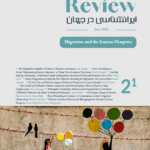/Book Review | Reading Time: 6 minutes
Tehrangeles Dreaming
Intimacy and Imagination in Southern California’s Iranian Pop
Amy Malek | June, 2025

It’s nearly impossible to attend an Iranian celebration—whether a wedding, party, or Nowruz gathering—anywhere in the world without hearing the infectious rhythm of “6/8” (shesh-o-hasht). This exuberant, dance-oriented music, though often associated with Tehran, was largely born in Los Angeles. Reactions to the genre are deeply split: for some, these songs evoke nostalgia and joy; for others, they are dismissed as shallow, clichéd, or even embarrassing. Strikingly, these dismissals come not only from audiences or musicians of other genres but also from some of the very artists and producers who created them.
Ethnomusicologist Farzaneh Hemmasi takes this widespread ambivalence as her point of departure in Tehrangeles Dreaming, a rich ethnographic account of Iranian pop music produced in Los Angeles. Drawing on extensive interviews with musicians, producers, and media figures, as well as close readings of music, videos, and media, Hemmasi reconstructs how 6/8 became the defining sound of Iranian diasporic music from the 1980s into the 2000s. Her analysis lays bare the transnational networks of production and circulation that created and consumed this music, and refutes the notion that Tehrangeles pop was merely “a bit of distraction from the seriousness of revolution, war, economic hardship, and displacement” (p. 37). She argues instead that it formed a vital space of cultural memory and identity, becoming a soundtrack to multiple generations of Iranian life both in Iran and its diaspora, one that was “vital to Iranian social life” (p. 58).
While much scholarship on Iranian music has focused on classical, traditional, or more recently, underground genres like rock and hip hop, Hemmasi turns her lens to the long-overlooked realm of diaspora-produced pop. Centering Los Angeles, home to both the largest Iranian population outside Iran and the post-revolutionary artists who shaped Tehrangeles music, the book offers a critical reappraisal of a genre long seen as lowbrow. Despite a commonly repeated belief that Los Angeles is overrepresented in the social scientific literature on the Iranian diaspora, prior to Hemmasi’s book, Tehrangeles actually has not been given the ethnographic attention it deserves. Earlier volumes collected the experiences and emotions of exile in the first decade following migration, but these early oral histories and essays still remain the key sources for scholarship about a community entering its fifth decade. Tehrangeles Dreaming thus breaks new ground, presenting a detailed ethnography of the “founding cohort of Iranian music and media producers in Southern California” who “became champions of salvaged and alternative versions of national culture precisely as they met with rejection in their home country” (p. 8).
These early chapters of the book act as a form of historiography, capturing the voices of now-retired or deceased artists who helped define Iranian popular music in exile. Their recollections—tinged with frustration, nostalgia, and resignation—document the struggles to create Iranian pop music and, later, to adapt across decades of media change, from single-location studios, cassette tapes, and CDs to digital platforms. Together, their stories challenge cultural hierarchies and histories that have long dismissed mardomi or motrebi music as “low-status,” revealing instead the political and affective force of diasporic cultural production.
One of Hemmasi’s key interventions is to explore how repression in post-1979 Iran created conditions for a cultural boom abroad. The Islamic Republic’s censorship—banning women’s solo singing and “Western-influenced” music, including 6/8 pop—effectively exiled pre-revolutionary celebrities and artists (musicians, producers, songwriters, singers, dancers). Paradoxically, this very marginalization enabled a resurgence of popular music abroad and created a renewed raison d’etre for this form to flourish. Rather than heralding the death of 6/8’s popularity, as Hemmasi shows, strict censorship at a time of war-induced fear and depression heightened public craving for joyful soundscapes, which only exiled musicians could provide. These musicians found both creative and economic purpose in responding to these demands, made possible through technological affordances such as easily dubbed and transnationally circulated cassette and video tapes. Although eager to experiment, Tehrangeles artists were also encouraged to produce the familiar 6/8 sound for the diaspora, quickly producing new tunes and chintzy music videos to fulfill a heightened need for upbeat music for local Iranian social gatherings which had taken on an added urgency in exile. As Hemmasi’s interlocutors put it, “musicians played at their patrons’ pleasure, and their experiments with other forms of art were neither appreciated nor compensated” (p. 57). The result was the dominance of a groove that came to define not only LA’s Iranian soundscape but also a “synergistic relationship of domestic prohibitions [and] expatriate business strategies” (p. 7) between Iran and its diaspora.
Tehrangeles Dreaming is also deeply engaged with questions of intimacy and imagination. Hemmasi draws on the concept of “dreaming” in the title to theorize how Iranian cultural producers in exile fashioned affective and symbolic connections to a homeland that often rejected them. Like others in the diaspora who are “doubly estranged” (p. 24) from post-revolutionary Iran—both ideologically and physically—the founding generation of Tehrangeles cultural producers turned to imagination to bridge the gap. Through musical transcriptions, song lyrics, music videos, and artist interviews, Hemmasi traces how fantasy, desire, and dreams animate this cultural world, mediating a “dialectic of physical and temporal distance and music-, media-, and communications-enabled closeness” (p. 26). The resulting transnational social imaginaries materialized through sound and image form what Michael Herzfeld called “cultural intimacy” (p. 28), the common understandings, experiences, memories, and sociality that bind a community. Hemmasi explores how Tehrangeles musicians have collectively grappled with desires and paranoias they share, whether about the Islamic Republic’s reach or persistent doubts about their popularity among Iranians, or the enduring “rueful embarrassment” associated with shesh-o-hasht. These ambivalences, far from undermining the music’s cultural power, are part of what build these common social imaginaries and make 6/8 such a resonant site of identity-making in exile.
The centrality of politics to a musical genre that is often dismissed as shallow and apolitical is a thread running throughout Tehrangeles Dreaming. The book’s organization mirrors this: early chapters unpack the political conditions that shaped the people, music, and audiences of the Tehrangeles scene, while the last two chapters focus on individual artists with explicit political aims. Chapter 1 traces the rise of the 6/8 sound in its diasporic capital of LA, revealing its deep roots in early and mid-20th century Iran. Chapter 2 shifts to a historical ethnography of the Tehrangeles industry, weaving together sometimes contradictory memories to underscore the challenges of reconstructing exile histories. Hemmasi is careful not to assert an authoritative history, nor to allow any one of her interlocutors to do so; rather, she insists on recognizing the often messy, conflicting, and unverifiable accounts as part of the challenge of historical memory.
Chapter 3 deepens the analysis through the lens of gender and sexuality. Using Mankekar and Schein’s concept of “transnational media erotics” (p. 99), Hemmasi examines how men and women artists navigated the challenges of overlapping and sometimes conflicting moral regimes and norms of respectability and desirability for a transnational audience.This sets the stage for Chapters 4 and 5, focused on two towering figures in Iranian pop with broad, global, and loyal fanbases: Googoosh and Dariush. Googoosh, Hemmasi argues, has “fuse[d] female singing and political expression in newly audible ways” (p. 123), while Dariush’s widespread appeal is underpinned by shared narratives of suffering that create forms of public intimacy and emotional resonance.
The concluding chapter reflects on shifts in the Iranian pop landscape since 1979, particularly in light of digital transformations that reshaped the music industry starting in the 2000s. Hemmasi’s interviews and fieldwork, conducted in this transitional period of the mid- to late 2000s, gesture toward the decline of the original Tehrangeles scene. With the dispersal of production across digital platforms and global locations, this was a critical turning point for the music industry writ large. Given that the Tehrangeles pop music industry thrived in a pre-internet time when recording studios and the artists who relied on them were clustered in the San Fernando Valley, questions arise: what becomes of this industry, and the cultural intimacy it relied upon and contributed to, in the digital age? What new modes of production, circulation, and promotion by the second generation and by newly-arrived immigrants have replaced those established by the founding generation? Do the new sounds of Iranian music, produced in diverse global locations, produce new intimacies? And can Tehrangeles retain its symbolic power in the diaspora without its once-dominant music industry? These questions, only briefly explored, open rich pathways for future research—on second-generation artists, newer immigrant musicians, and the evolving politics of diasporic sound.
Beautifully written and sharply argued, Tehrangeles Dreaming is a significant contribution to the study of exile cultural production and diasporic identity formation. Scholars of ethnomusicology, anthropology, Middle East studies, and cultural studies will find much to engage with here. In centering a genre long dismissed and a diaspora long stereotyped, Hemmasi offers a much-needed corrective—and a compelling invitation to listen more closely.










Comments are closed.